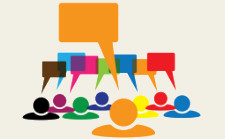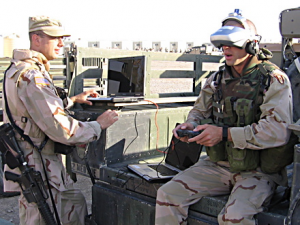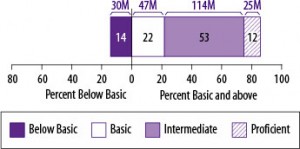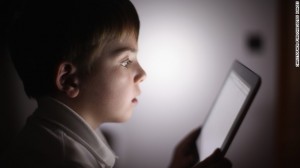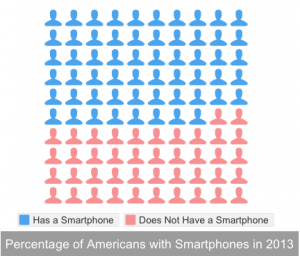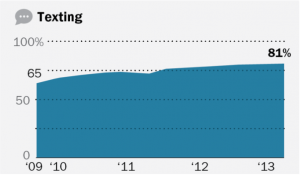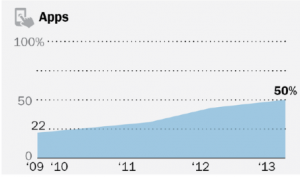http://sam-app.org.uk/
Category Archives: Communication
A New Approach to Treating Mental Illnesses
While we often think of new applications of medical technology as having vast implications for the treatment of many diseases, mental illnesses are often left out the discussion. This exists due to the deeply ingrained stigma in our culture that mental illnesses are not “real” diseases. However recent advances in technology have had a large influence on addressing the stigma of mental illness and providing new treatment approaches for mental illnesses.
One of the greatest impacts of new technology on mental illnesses is creating an online forum where people feel comfortable discussing their illness and can connect with others who are living with the same illness. While technology enables this for a variety of illnesses, it is especially important for mental illnesses because people with a mental illness can often feel isolated and feel pressure to hide their illness. Reading the stories of others, who are facing the same type of struggles, can encourage someone to seek treatment. The information available online creates an open dialogue in which we all can become better educated on mental illness, which will hopefully begin to break down the stigma ingrained in our culture.
New advances in technology are also impacting the treatment for various mental illnesses. One particular multimedia program that is garnering attention is called Virtual Reality, and was developed for patients with Post Traumatic Stress Disorder. The program is based on exposure therapy, and uses specially programmed computers to create an artificial environment designed to be similar to scenarios a veteran experienced during combat. This program has also been shown to reduce a number of phobias, including arachnophobia, by having patients work their way through various scenarios that include their phobia, thus becoming more accustomed to their fear.
Future advances for the treatment of mental illnesses might involve applications that sense when a user’s mood is changing or if the user is in a high-risk situation. Mood could be tracked using physiological measures, and could signal a potential manic or depressed state. Location could be correlated to mood, and send a comforting or alerting message to the user if they are in an area where they normally experience high stress. For example, if a phone detects someone who has been diagnosed with depression with a predisposition towards alcoholism buying alcohol alone late at night, it could alert a family member to check on their loved one. While promising, these new features lead to many privacy and security concerns. Although it might seem easier to limit the app to solely the patient, allowing the patient’s family and friends to be part of the treatment plan is essential, especially for mental illnesses.
While technological innovations for the treatment of mental illness are advancing rapidly, the technology out there lags behind many other “typical” diseases. Hopefully, even more innovative treatment approaches will soon be created, creating a brighter future for the treatment of mental illnesses.
EMR vs. EHR: What does it really mean?
One of the topics that we have discussed on varying occasions throughout the semester is electronic health records (EHR) and how they interact with and effect patient care. In my own groups work with our problem owner in the CV ICU, interaction with the EHR has been a large part of developing a solution. As I have continued to work with and research the present systems, I have noticed, both in the classroom and in the hospital environment, an inconsistency in terminology used to refer to the records. From what I observed, the terms electronic medical record (EMR) and electronic health record (EHR) are often used interchangeably. Curious, I looked to see if there was an actual difference between these two records and how they are involved in medicine.
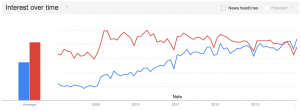
Google Trend Data Tabulating Searches for “EMR”and “EHR”
Though these terms are often used synonymously, there are marked differences between EHRs and EMRs and how they are used within the medical field. My research led me to discern that the term EMR refers to essentially a digital version of the paper charts that they replaced. These digitalized systems contain a patients medial and treatment history specific to a doctors practice and posses the ability to allow caretakers to track data over time, identify which patients are due for screenings or appointments, and monitor quality of care within the practice. The largest difficulty when using EMR is transfer of information out of a physicians practice, and in that sense does not improve significantly from a paper record.
So how do EHRs differ from what I have just described? The key difference between an EMR and EHR is the focus of use. As described by a variety of sources, an EHRs functional aim is to address the total health of the patient, going beyond the original health organization to encompass information from other health providers including laboratories, specialists, and most importantly the patients themselves. The ability to share information in a secureway throughout all aspects of patient care creates the possibility for interactive communication and the meaningful use of EHRs as a tool to improve patient care.
Overall, what I found is that while the terms EMR and EHR only differ by one word, that small change makes a world of difference. The engagement and commination opportunities that the EHR provides, makes a case for the use of these systems exclusively. A push for providers to engage patients through their access to the EHR system has occurred in recent years, but is this engagement really effectual and beneficial to patient care? With an estimated 77 million Americans that possess either basic or below basic health literacy, are EHR systems providing accessible and useable information to patients to improve their care or are many patients just getting lost in the process?
To answer that question the Agency for Healthcare Research and Quality have examined health education materials delivered by EHRs and have determined that many do not often account for the poor health literacy possessed by a large amount of the population. So what can we do to make EHR systems more useable for patients and improve care outcomes?
A number of leaders of Health IT have begun address this disparity by suggesting a list of preliminary standards and key tools designed to be incorporated into the existing and new EHR systems. A number of simple changes to improve direct communication with patients include providing patients with the ability to identify their preferred language. Other functions including the ability of EHRs to filter quality measures by patient characteristics such as language, socioeconomic status, and education level, could work to reveal and address disparities in care, including those involving health literacy. In addition to providing better resources for patients, having EHRs include information such as disability status, sexual orientation, or gender identity can provide caregiver a greater context regarding a patient’s health recommendations and outcomes. While these changes serve as the initial push in addressing functional and health literacy changes to EHRs, there are still ways to improve the educational value of the interactive system.
What other innovations could be incorporated into EHR systems in improve health literacy?
Too Much of a Good Thing
A recent article published in the Argus Leader from Sioux Falls, SD highlights the difficulty that parents face in controlling their children’s internet usage. The article cites research by a distinguished pediatrician that determined social media can have a very negative impact on children. Heavy media use can be a detriment to a child’s health and social life. Therefore it is imperative that parents find a way to limit their child’s exposure to media on the internet and social media. Unfortunately many parents are not as savvy as their children when it comes to the internet so they do not understand the risks involved and potential consequences of excessive use. Nor do they know how to limit use or how much limitation is sufficient. Clearly children need to utilize the internet as a source of information and mental stimulation so it is crucial parents know where and when to cut down on internet use.
Some side effects associated with excessive exposure to the internet are lack of sleep and poor nutrition. Children need eight to ten hours of sleep a night and a balanced diet in order to develop properly and avoid health complications in the future. The internet acts as an escape and a distraction from normal life so kids these days spend more time indoors than ever before. They are also affected socially as interaction with others online hampers their face to face communication skills and ability to empathize. Substituting electronic for real life personal interaction leads to a poor understanding of facial expressions, tone and nuance in everyday conversation.
Due to these mal-effects of the internet on a child’s life it is imperative that parents limit online usage. As the author of the article points out, unfortunately parents do not understand the internet and mobile applications very well, often less than their children. Therefore, parents need to establish communication with the children in order to further their understanding and protect their children. This necessary role reversal makes for an interesting modern family dynamic.
As we move through this class trying to increase the use of mobile technologies and the internet to better patient care it is important to remember that there are physical and mental side effects associated with it. Every solution no matter how beneficial contains inherent negative side effects. We also need to understand that the baby boomer generation is not as well versed in technology as our generation. Therefore when designing solutions to issues in healthcare that involve the internet and media we must teach rather than simply provide. Overall tech literacy must be increased or else our solutions will remedy little and confound many.
Argus Leader Article: http://www.argusleader.com/story/news/2014/04/08/children-face-health-risks-social-media-overload/7452213/
Mindful mHealth
In the past several years, there has been increased discussion about bringing medicine into the technological era, and out of the darkness of paper methods and inefficiency. Words and phrases like “media,” “digital,” and “mobile technologies”are becoming more and more linked to healthcare. Because we do live in the age of technology, a time when nearly every person in America owns a cell phone (91%) and uses the internet, such a movement seems not only favorable, but necessary. As we push medicine into the digital age, we applaud new, innovative uses of advanced technology for testing, treating, and tracking—for features that allow the new age of “ePatients” to take control of their health.
One of the most “fashionable” new technologies is the mobile app. Apps allow patients to use their mobile phones to track their diet, exercise, blood pressure, etc. With so many emerging uses, smartphones provide a promising avenue to increased ePatient activity. As a result, when people think of patient-centered health media, the first thing that comes to mind is generally mobile apps—or is it?
When I say “people,” this is a very biased demographic. I am a Rice University student in a Medical Media Arts class. While my peers come from very diverse backgrounds, our current lifestyle places us in a specific demographic—that of educated young people who are exposed to mobile technology, specifically smartphones, on a daily basis. Those developing mobile health technologies generally come from similar backgrounds, in that they are most likely very familiar with smartphone usage, and quite possibly own smartphones themselves. For a significant portion of the population, this is not the case.
According to Pew Research, only 58% of Americans own a smartphone. While this is more than half of the population, this still means that roughly 131.8 million Americans (42%) do not own a smartphone or have access to mobile applications.
One of the many advantages of mobile technology is its ubiquitous nature and its potential to bridge health disparities by reaching large, diverse populations. However, if all of our focus is placed in a sector of mHealth that such a significant portion of people do not have access to, we are only compounding health disparities with a technological one.
While I believe that mobile applications are a very promising avenue of healthcare, I think that other mobile phone capabilities should continue to be utilized. For example, while only 50% of cell phone owners download mobile apps, 81% send and receive text messages. Text messaging is a simple, low-cost technology, which can be utilized with or without a smartphone, and has consistently been in greater use than mobile apps.
While text message-use is beginning to level-out, mobile app usage is still increasing. However, until the transferral to mobile apps is complete, the “non-app” population should not be ignored. Text message-based mHealth campaigns have already been developed, such as Txt4health, SmokefreeTXT, and text4baby. All of these services promote positive health behaviors by sending text message reminders to patients in the program. We should use these programs as models while we consider avenues that promote patient-centered healthcare and patient engagement, and be mindful of who we are trying to reach and how to best reach them. While mobile applications are a promising platform, which should definitely be utilized, we also have to ensure that we make mobile technologies the solution and not the problem in addressing health disparities.

